Structure of intestinal mucosal barrier and effects of Clostridium butyricum, aflatoxin and Vibrio parahaemolyticus on intestinal structure of Penaeus vannamei
- Categories:Technical article
- Author:JBH BIO
- Origin:Henan Jinbaihe Biotechnology Co.,LTD
- Time of issue:2022-07-31 16:42
- Views:
Structure of intestinal mucosal barrier and effects of Clostridium butyricum, aflatoxin and Vibrio parahaemolyticus on intestinal structure of Penaeus vannamei
- Categories:Technical article
- Author:JBH BIO
- Origin:Henan Jinbaihe Biotechnology Co.,LTD
- Time of issue:2022-07-31 16:42
- Views:
The intestinal tract of Penaeus vannamei is not only an important place for nutrient digestion and absorption, but also an important immune organ. It is the first line of defense of immunity, and its barrier function can be divided into four categories: mechanical barrier, chemical barrier, immune barrier and biological barrier.
Intestinal mucosal barrier of Penaeus vannamei
1.Mechanical barrier: It is composed of intestinal epithelial cells and intercellular junctions, including tight junctions, adhesion junctions, desmosomes, gap junctions, and tight junctions to form the permeability barrier of intestinal epithelial cells. Intestinal pathogenic substances destroy cell tight junctions, increase intestinal permeability, and reduce intestinal disease resistance.
2.Chemical barrier: Composed of the mucus layer on the surface of intestinal epithelial cells, there is a perifeeding membrane in the intestinal tract of Penaeus nannanensis, which is composed of protein (digestive enzyme immune-related protein, antioxidant protein, chitinase, etc.) chitinpolysaccharide network structure. The perifeeding membrane can not only assist digestion and absorption, but also protect the intestinal tract from the invasion of feed particles and pathogenic microorganisms Studies have shown that the expression of some immune protein genes is up-regulated in white shrimp infected with Vibrio WSSV.
3. Immune barrier: Inborn (or non-specific) immunity is predominant. Invertebrate recognition receptors include peptidoglycan recognition proteins (PGRPs), Gram-negative bacterial binding proteins (GNBPs) or lipopolysaccharide and β-1, 3-glucan binding proteins (LGBPs), C-type lectins (C-type) Lectins (CTLs), galectins (galectins), lipoproteins containing sulfur (TEPs), fibrinogen associated proteins (FREPs), scavor receptors (SRs), Down syndrome cell adhesion molecules (DSCAMs) and Toll-like receptors (TLRs) were the main Yang ET Al et al. found that TLRs were involved in the immune response against Vibrio and WSSV, and reactive oxygen species (ROS) and antimicrobial peptides (AMPs) were also involved in the immune barrier.
4.Biological barrier: usually refers to the symbiotic bacteria of intestinal tract normal, can compete with pathogenic bacteria adhesion sites such as nutrition, also participated in the regulation of congenital immune response, can control the life activities of the metabolites abundance of probiotic bacteria in the intestine South America white shrimp immune activity and living environment of change will change the structure of intestinal normal flora
Effects of aflatoxin B1 on intestinal structure
Aflatoxin 15mg/kg was added for 12 days
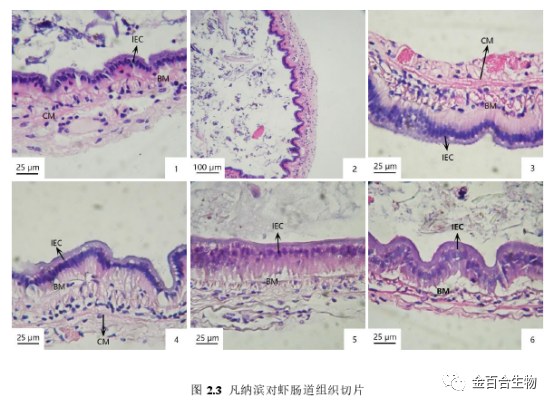
On the 4th day of challenge, there was a gap between intestinal epithelial cells and basement membrane, and the edges of some nuclei were blurred. On the 8th to 12th day, intestinal epithelial cells showed hypertrophy of nucleus, blurred intercellular space, and the epithelial cell layer was separated from basement membrane. This indicates that aflatoxin B1 causes mechanical damage to the intestinal mucosa of Litopenaeus vannamei, that is, it destroys the intestinal physical barrier to a certain extent, and then may affect other intestinal functions.
Effects of Vibrio parahaemolyticus on intestinal structure
Vibrio parahaemolyticus was challenged for 12h at a concentration of 5×107 CFU/ml
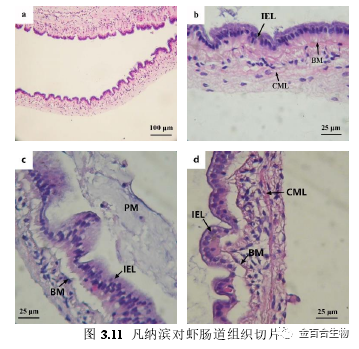
After infection with Vibrio parahaemolyticus, the intestinal epithelial cells were separated from the basement membrane, and the nuclei of the epithelial cells were hypertrophic and the nuclear margins were blurred.
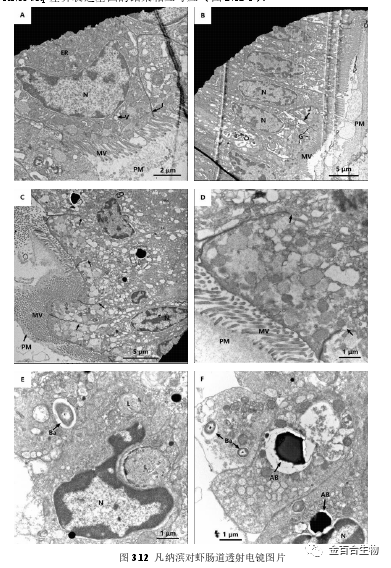
Transmission electron microscopy showed that the apical space of infected Vibrio parahaemolyticus cells became larger, the intercellular connections were damaged, and the boundaries were blurred, but the perifeeding membrane still existed (Figure 3.12-C,D). The morphology of the nuclei of some cells was changed, including pyknosis of the nuclei and clusters of chromosomes around the nuclear envelope, and lysosomes near the nuclei (Figure 3.12-E). The microvilli of some cells fell off and tended to become spherical. Bacteria entered the cells and were wrapped by vesicles. Cavities appeared inside the cells and apoptotic bodies appeared (FIG. 3.12-F).
Effects of Clostridium butyricum on intestinal structure
Shrimp intestinal tract was treated with six forms of Clostridium butyricum live bacteria (LS), Clostridium butyricum spray dried spores (DS), Clostridium butyricum broken (CE), Clostridium butyricum fermentation supernatant (FS), and Clostridium butyricum live bacteria + metabolites (LCS) for 42D

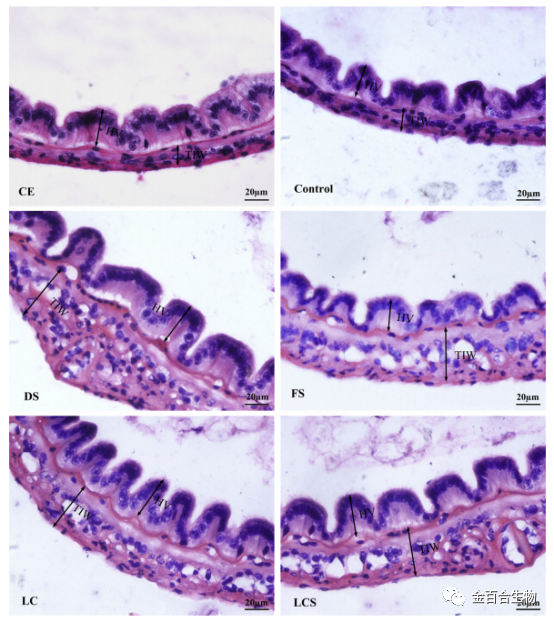
It can be seen that DS, LC and LCS groups significantly increased the height of intestinal villi and the thickness of intestinal wall
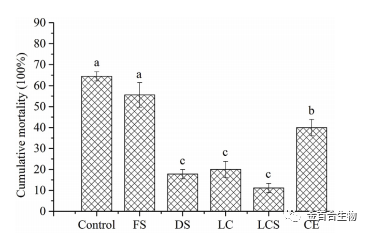
In addition, 14 days after Vibrio parahaemolyticus challenge, the mortality of DS, LC, LCS and CE groups was lower than that of the control group
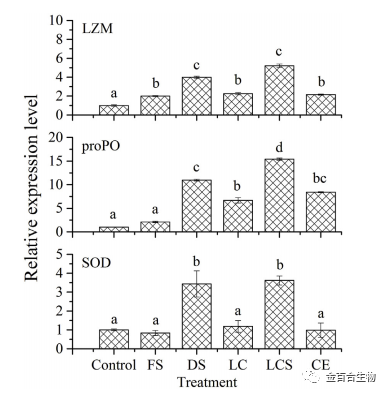
The expression of proPO gene in hepatopancreas of DS, LC and LCS groups was significantly higher than that of the control group, indicating that these three groups play an important role in the resistance to pathogen invasion of white shrimp. The expression of LZM gene in FS, DS, LC and LCS groups was significantly increased, indicating that these treatments played an important role in the expression of immune enzymes. SOD gene expression was significantly increased in DS and LCS groups. SOD can eliminate the reactive oxygen species produced in the host under the stress of temperature, hypoxia, pH, toxicants and pathogens to maintain cellular homeostasis.
In conclusion: Clostridium butyricum is of great value in maintaining the intestinal structural integrity of Penaeus vannamei. The mixture of Clostridium butyricum spores, viable bacteria and supernatants can be used as effective immune stimulants to produce proPO, LZM and SOD to protect shrimp from pathogens.
Service Hotline:
Tel:+86-371-61779068
Phone:+86-18602468822
WhatsApp:+86-15717345927
Skype: +86-18639087551
Email:melody@jbh2013.com
Add: Fudao Town, tangyin county, Anyang City, Henan Province
Copyright © 2020 Henan JBH Bio-Tech Co., Ltd 豫ICP备15035929号 Business License Powered by : www.300.cn SupportedIPV6

